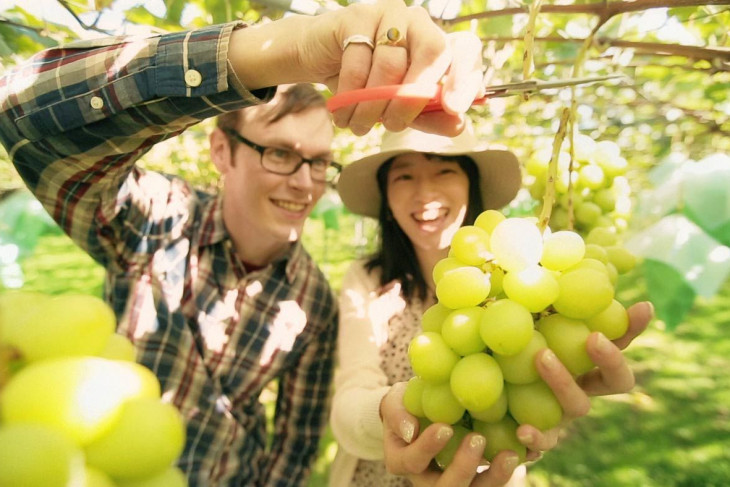
Fukushima Prefecture is one of the leading fruit production regions in Japan, to the extent that Fukushima City is often called the 'Fruit Kingdom,' and there is a road within the city limits with the nickname 'Fruit Line.' As hinted at by the name, the road is surrounded by fruit orchards on both sides for a distance of over 14 kilometers. If one looks closely, they will see different fruits growing during the year, with cherries in the springtime (early June to early July), peaches in the summer months (from mid-July to early September), pears (late August through early October) and grapes (early September through early October) in autumn, and finally apples in early winter (early October to early December).
During each season, the nearby fruit orchards bustle with activity as families and tourists come to buy the fresh, high quality fruit.
Fruit-Picking Experience
One pleasant way of enjoying the Fruit Line is to pick some fruit yourself, a popular pastime in Japan known as fruits-kari, meaning 'fruit-picking.' Fruit-picking is a luxury in Japan, available only in fruit-producing regions. In Japan, it's typical to be able to pick as much fruit as you'd like within a set time and enjoy it fresh on the spot.
However, unlike some orchards abroad, many Japanese orchards don't allow fruit picked as part of the fruits-kari experience to be taken out of the orchard. Fruit can be bought separately of course.
You need not bring or prepare anything to participate. You need but set out on an adventure that promises satisfaction with the deliciousness of the fresh fruit and the instinctive enjoyment of harvesting it.
Here we will describe how to go about fruit hunting using the example of an apple orchard. When you arrive at the orchard, sign up for the fruit-picking experience. After signing up, you will be provided with any necessary tools, such as instruments for cutting fruit from the branch or buckets. The staff will then give a brief introduction in Japanese on how to pick the fruit and how to tell the difference between ripe and unripe fruit, but the topic is one that is easy to grasp even just by watching their gestures as they explain, so Japanese language skills are not a requirement.
Then, after entering the orchard itself, there will be nothing but apples wherever you look. Your job is now to find the ones that look the tastiest from among all the others. Fukushima’s apples are known for being quite juicy and for a taste with a good balance of sweetness and tartness, the result of Fukushima’s uniquely wide temperature variation in the local climate. Take a bite of the apple and your mouth will be filled with the fresh juice accompanied by the appealing crisp sound. And if you really want to experience the taste, we recommend eating the apple as is without removing the peel first. You can also experience a variety of textures and sweetness levels depending on the variety of apple.
Fukushima City's Orchards
Many types of fruit are grown within the Fukushima City limits, and the volume of pears in particular is the second highest for Japan. Thus, the local farmers have plenty of opportunity to constantly improve their skills. Whereas the norm is to wrap individual fruits in little bags in Japan when they are still on the tree to protect them against pests, the orchards of Fukushima City more commonly grow fruits without using these bags, ensuring that each fruit receives more direct sunlight giving them a higher natural sugar content and richer taste.
There is also a recent and growing trend to design new confections that make use of these high quality fruits. These delicious desserts are possible specifically because the orchard farmers know what they’re doing when it comes to flavorful fruit. So if you have the time, we recommend combining your fruit-picking with a culinary tour of the available confections as well. The production of jams and juices using the fruits is also quite popular at Fukushima orchards, and those products make great gifts to take home with you.
The Fruit Line provides numerous ways to enjoy yourself depending on the season. When visiting, we recommend coming by car. That way you can enjoy the surrounding scenery as you drive, and the ability to stop by at any local farmer’s markets you may come across will further increase the charm of your trip.
Enjoy this luxurious experience and the tastes of the season to the fullest at your own pace, surrounded by the bounty of nature. Read here for more.


